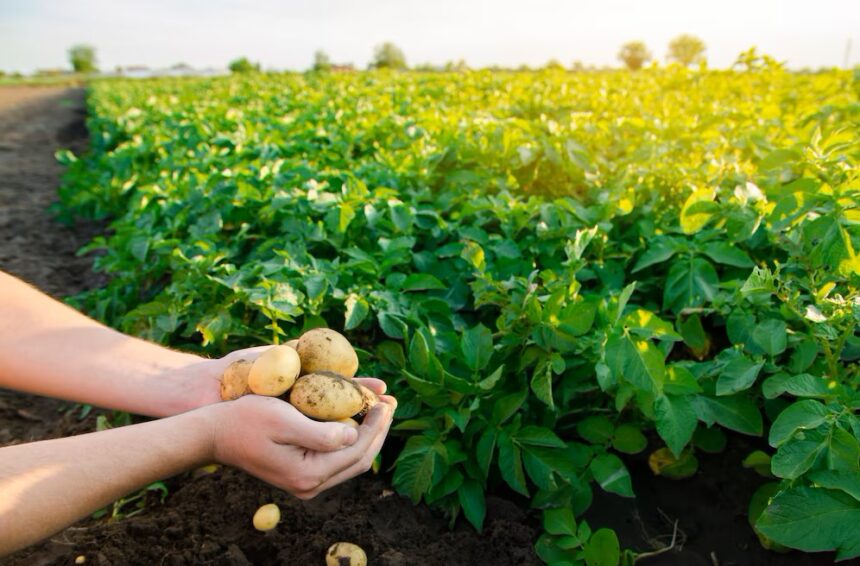Potatoes are a staple crop grown around the world, but like all plants, they are susceptible to a variety of diseases. Whether you’re a small-scale home gardener or a commercial farmer, recognizing the signs of common potato diseases early and knowing how to treat them can help protect your harvest and ensure healthy, productive plants. Here’s a guide to the most common potato diseases and how to deal with them effectively.
1. Late Blight
Cause: Phytophthora infestans, a fungal-like organism.
Symptoms: Dark, water-soaked lesions on leaves and stems that rapidly spread. Tubers develop brown, firm rot beneath the skin, often with a foul odor.
Treatment and Prevention:
- Fungicides: Use preventative fungicides like chlorothalonil or mancozeb, especially during wet weather.
- Cultural control: Destroy infected plants and tubers immediately. Practice crop rotation and avoid planting potatoes near tomatoes, which can also carry the disease.
- Resistant varieties: Grow late blight-resistant cultivars like ‘Sarpo Mira’ or ‘Valor’.
2. Early Blight
Cause: Alternaria solani, a fungus.
Symptoms: Concentric rings on older leaves, giving a “target” appearance. Leaves may yellow and drop off, reducing yield.
Treatment and Prevention:
- Fungicides: Apply fungicides early in the season, particularly during warm, humid weather.
- Cultural control: Remove and destroy infected plant debris. Ensure good spacing for air circulation.
- Balanced nutrition: Avoid over-fertilizing with nitrogen, which can make plants more susceptible.
3. Common Scab
Cause: Streptomyces scabies, a soil-borne bacterium.
Symptoms: Rough, corky lesions on the surface of the tubers, ranging from shallow to deep pits.
Treatment and Prevention:
- Soil pH management: Maintain soil pH between 5.0 and 5.2 to discourage the bacterium.
- Irrigation: Keep soil evenly moist during tuber formation to reduce scab development.
- Resistant varieties: Choose scab-resistant potato varieties like ‘Russet Burbank’ or ‘Superior’.
4. Blackleg and Soft Rot
Cause: Pectobacterium and Dickeya species.
Symptoms: Blackened, slimy stem bases and foul-smelling, mushy rot in tubers.
Treatment and Prevention:
- Seed quality: Use certified disease-free seed potatoes.
- Storage: Store tubers in cool, well-ventilated conditions to prevent soft rot.
- Sanitation: Disinfect tools and equipment regularly.
5. Potato Virus Y (PVY)
Cause: A viral infection spread by aphids and infected seed potatoes.
Symptoms: Mosaic patterns on leaves, leaf curling, and stunted growth. Yields may be significantly reduced.
Treatment and Prevention:
- Control aphids: Use insecticidal soaps or neem oil to reduce aphid populations.
- Use certified seed: Only plant virus-free, certified seed potatoes.
- Remove infected plants: Rogue and destroy infected plants early to prevent spread.
6. Fusarium Dry Rot
Cause: Fusarium species, a fungal pathogen.
Symptoms: Sunken, wrinkled spots on stored tubers that develop into dry, hollow cavities lined with spore masses.
Treatment and Prevention:
- Proper handling: Avoid bruising tubers during harvest and handling.
- Storage conditions: Store at 4–10°C in a dry, dark environment with good airflow.
- Seed treatment: Consider treating seed potatoes with fungicides before planting.
Best Practices for Disease Management
- Crop rotation: Rotate potatoes with non-solanaceous crops every 3–4 years to break disease cycles.
- Proper spacing: Allow enough space between plants to improve air circulation and reduce humidity.
- Sanitation: Clean up plant debris, disinfect tools, and avoid reusing old potato beds without treatment.
- Healthy soil: Maintain well-draining soil rich in organic matter to promote plant vigor and natural disease resistance.
Managing potato diseases requires a combination of preventative strategies, prompt identification, and targeted treatment. By staying informed and proactive, you can protect your potato crop and enjoy a healthy, abundant harvest.







